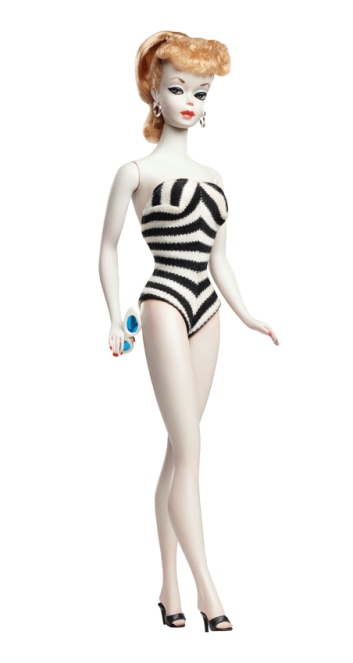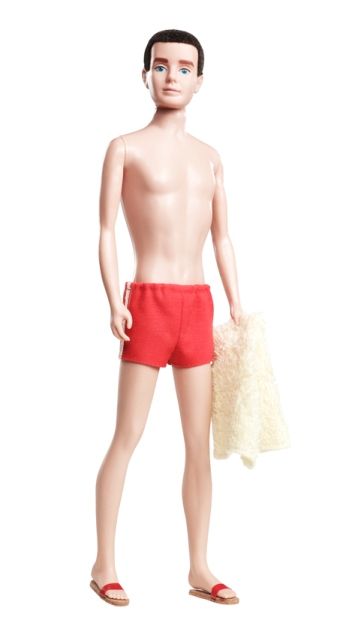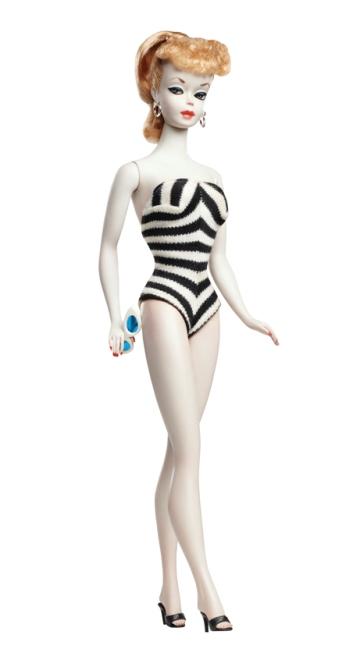Some of the objects in California Design, 1930–1965: "Living in a Modern Way” were available for purchase for as little as $3 when they were new, including an original 1959 Barbie doll and her boyfriend, Ken, introduced in 1961. A popular icon and a lightning bolt of cultural relevance, Barbie was marketed as a "Teenage Fashion Model” doll and an aspirational toy with clothes for any occasion.
LACMA's Barbie and Ken dolls are gifts of Mattel, Inc., sponsor of California Design. The postwar California success story of Mattel and the design and salesmanship behind the iconic Barbie brand pairs perfectly with the story of innovation inCalifornia consumer goods that is a theme of the exhibition. Barbie embodies the carefree confidence and utter versatility that characterized postwar California. (You can also take Barbie home with you after seeing the exhibition.)
Formed in 1945 by Harold Matson (Matt) and Elliot (El) and Ruth Handler in a Los Angeles garage, Mattel initially manufactured picture frames but soon found success making toys. Ruth, co-founder and later president of Mattel, had long wanted to create an adult, three-dimensional fashion doll onto which a child "could project her own dreams of the future." (This was in contrast with the typical baby doll.) The inspiration for Barbie doll came as Ruth watched her daughter Barbara playing with paper dolls. Mattel began to develop the design for Barbie with a team led by Jack Ryan, a former missile designer for Raytheon. Barbie doll debuted at the New York Toy Fair in 1959.

Mattel, Inc., Barbie Teen Age Fashion Model (Barbie #1), 1959, gift of Mattel, Inc.
With cat-eye sunglasses in her vinyl hand, blonde ponytail, and high heels, Barbie exudes modern California style and Hollywood glamour. She models the iconic and sophisticated black-and-white striped jersey swimsuit, black mule shoes, and gold hoop earrings with which she was originally sold. The original Barbie doll also came with a display pedestal with two prongs that inserted into holes in her feet (a feature only seen on the #1 Barbie.

Mattel, Inc., Ken doll, 1961, gift of Mattel, Inc.
Ken doll was introduced in 1961 in response to popular demand for a male companion for Barbie (they have never officially wed despite countless trips to the altar in wedding finery). A rare example with flocked hair (a short-lived design detail because it rubbed off when exposed to water), this Ken doll is also ready for the beach in his red swim trunks, cork sandals, and yellow terry cloth towel.
Barbie doll's wardrobe was designed by Charlotte Johnson, a freelance fashion designer and teacher at Chouinard Art Institute before she became the director of Barbie wardrobe from 1957 to 1980. Each doll came with a catalogue of fashions that the young consumer could purchase separately. Elliot Handler described this as the "razor and razor blade" marketing strategy, which could turn the $3 doll into a major investment: "You get hooked on one and you have to buy the other. Buy the doll and then you have to buy the clothes."
The first Barbie commercial premiered on television during The Mickey Mouse Club, which had proven to be a successful advertising platform for Mattel. By summer, she was a sensation; she went on to become the world’s bestselling doll.
Jennifer Munro Miller, Research Assistant, Decorative Arts and Design



